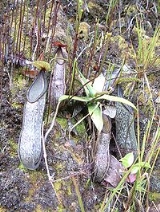
Nepenthes sp. Sulawesi
Encyclopedia
Nepenthes sp. Sulawesi is an undescribed
tropical pitcher plant
endemic to Central Sulawesi
, where it grows on at least 5 mountains. It is very similar to both N. hamata
and N. tentaculata
.
Shigeo Kurata
apparently confused this taxon
with N. hamata in his description of the latter (as N. dentata).
Undescribed taxon
In taxonomy, an undescribed taxon is a taxon that has been discovered, but not yet formally described and named. The various Nomenclature Codes specify the requirements for a new taxon to be validly described and named. Until such a description has been published, the taxon has no formal or...
tropical pitcher plant
Pitcher plant
Pitcher plants are carnivorous plants whose prey-trapping mechanism features a deep cavity filled with liquid known as a pitfall trap. It has been widely assumed that the various sorts of pitfall trap evolved from rolled leaves, with selection pressure favouring more deeply cupped leaves over...
endemic to Central Sulawesi
Central Sulawesi
Central Sulawesi is a province of Indonesia located in the centre of Sulawesi. It was established on 13 April 1964....
, where it grows on at least 5 mountains. It is very similar to both N. hamata
Nepenthes hamata
Nepenthes hamata is a tropical pitcher plant endemic to Sulawesi, where it grows at elevations of 1400–2500 m above sea level.The specific epithet hamata is derived from the Latin word hamatus, meaning "hooked"...
and N. tentaculata
Nepenthes tentaculata
Nepenthes tentaculata , or the Fringed Pitcher-Plant, is a tropical pitcher plant with a very wide distribution across Borneo and Sulawesi...
.
Shigeo Kurata
Shigeo Kurata
is a Japanese botanist and Nepenthes taxonomist whose work in the 1960s and 1970s contributed much to the current popularity of these plants. Of particular note is his 1976 guide, Nepenthes of Mount Kinabalu....
apparently confused this taxon
Taxon
|thumb|270px|[[African elephants]] form a widely-accepted taxon, the [[genus]] LoxodontaA taxon is a group of organisms, which a taxonomist adjudges to be a unit. Usually a taxon is given a name and a rank, although neither is a requirement...
with N. hamata in his description of the latter (as N. dentata).

